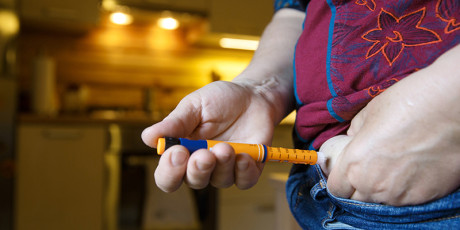Samenvatting
Abstract
Huls MHJ, Van Dijk MJ, Boesten ML. Curing diabetes mellitus type 2? Huisarts Wet 2013;56(2):70-3.
Increasingly more people with diabetes are achieving long-lasting normoglycaemia as a result of lifestyle changes or bariatric surgery, but there are no national guidelines for general practitioners on the management of such patients. Both the literature and research indicate that it is better to refer to diabetes remission rather than cure. This is not only because of the underlying pathophysiological mechanisms but also because of the risk of recurrence after remission. In addition, the term ‘cure’ suggests that the diabetes-induced organ damage resolves once normoglycaemia has been achieved. Disease-specific (microvascular) and generic (macrovascular/cardiovascular) complications remain, to a greater or lesser extent, even if long-term normoglycaemia has been achieved. There is also irreversible tissue damage, so-called metabolic memory. Studies have shown that mortality and morbidity are reduced after remission in patients who have undergone bariatric surgery, but this has not yet been demonstrated for lifestyle changes. We advise general practitioners to follow the consensus guideline of the American Diabetes Association for the management of patients with remission of diabetes mellitus type 2. This is compatible with the Diabetes Mellitus Guideline and the CVRM Guideline of the Dutch College of General Practitioners, which take various risk factors into consideration. It remains essential to monitor macrovascular complications; microvascular complications should also be monitored, but this can be done less frequently.
De kern
-
Steeds meer diabeten bereiken langdurige normoglykemie zonder medicatie.
-
Er zijn geen landelijke richtlijnen die aangeven hoe huisartsen hiermee om moeten gaan.
-
Op grond van de onderliggende pathofysiologische mechanismen kan men in deze gevallen beter spreken van remissie en niet van genezing van diabetes.
-
Follow-up op macrovasculaire complicaties blijft noodzakelijk.
-
Follow-up op microvasculaire complicaties kan men verminderen, maar niet staken.
Inleiding
Het is een vraag waarmee elke huisarts te maken krijgt: wat doe je met een diabetespatiënt die langdurig normale bloedglucosewaarden heeft? Daarbij bereikt deze patiënt de normoglycemie nogal eens zonder glucoseverlagende medicatie. Zo blijkt uit het ADDITION-onderzoek, waarbij men huisartsenpraktijken screende op diabetes mellitus type 2, dat 43,6% van de ontdekte patiënten ook 5 jaar na het stellen van de diagnose geen glucoseverlagende medicatie nodig had.1 Daarnaast zorgt de toename van het aantal uitgevoerde bariatrische ingrepen ook in Nederland, van 800 in 2003 naar 3500 in 2008, voor meer ‘normoglykemische diabetespatiënten’.23 Bariatrische chirurgie heeft namelijk een zeer positieve invloed op diabetes mellitus type 2. Zo bleek reeds in 1995 dat bariatrische chirurgie bij 82,9% van de patiënten een terugkeer naar normoglykemie tot gevolg had.4
De NHG-Standaard Diabetes mellitus uit 2006 beschrijft hoe men de diagnose diabetes moet stellen en geeft richtlijnen ten aanzien van de behandeling.5 In de standaard staat echter niet wat het beleid moet zijn na het bereiken van langdurige normoglykemie zonder medicatie. Kan de huisarts bij deze patiënten de diagnose diabetes type 2 schrappen? Hoe lang moet hij deze patiënten in een diabeteszorgprogramma controleren en met welke frequentie moet dat gebeuren?
Dit artikel probeert op deze vragen antwoord te geven. Namens de DiHAG (Diabetes Huisartsenadvies Groep) geven we tevens een advies.
diagnose schrappen?
Genezing of remissie?
Om de diagnose diabetes te schrappen zou de ziekte genezen moeten zijn. Kan diabetes mellitus type 2 eigenlijk wel genezen? Of is het juister van remissie van de ziekte te spreken? We definiëren genezing als het volledig herstel van goede gezondheid. Van partiële remissie is sprake als de ziekteverschijnselen of symptomen van de ziekte verminderd zijn. Bij volledige remissie zijn de ziekteverschijnselen of symptomen geheel verdwenen. Bij remissie is het per definitie mogelijk dat de ziekteverschijnselen terugkeren.6 We moeten naar onderliggende mechanismen kijken om deze vragen te beantwoorden.
De oorzaken
We kunnen dus pas van genezing van diabetes mellitus type 2 spreken als er sprake is van een volledig herstel van goede gezondheid. Dat is het geval als de onderliggende oorzaken én de gevolgen van de ziekte verdwenen zijn. Het is echter onmogelijk dé oorzaken van diabetes mellitus type 2 aan te wijzen: een ingewikkeld samenspel van oorzaken en mechanismen leidt uiteindelijk tot het manifest worden van de ziekte. Naast de usual suspects als obesitas, genetische predispositie, bèta-celverlies en insulineresistentie, spelen hier nog vele andere, bekende of onbekende factoren mee. Het valt dus niet te beoordelen of alle onderliggende oorzaken verdwenen zijn.
Hoewel een aantal oorzakelijke factoren mogelijk verdwenen kan zijn bij het realiseren van langdurige normoglykemie (obesitas, insulineresistentie), zullen andere factoren in ieder geval geheel of gedeeltelijk aanwezig blijven (genetische predispositie, bèta-celverlies in de pancreas).789 Concluderend: als we naar de oorzaken van diabetes kijken kunnen we beter van remissie, dan van genezing spreken.
De gevolgen
De ingewikkelde situatie rond de oorzaken van diabetes mellitus type 2 zorgt ervoor dat we de diagnose ook niet stellen op basis van oorzaken, maar op grond van wat we meten. Daarbij maken we onderscheid tussen diabetes mellitus type 2 en type 1 op basis van de aanwezigheid respectievelijk de afwezigheid van een nuttige restinsulinesecretie.10 Vervolgens zijn de afkapwaarden, waarboven een patiënt de diagnose Impaired Fasting Glucose (IFG), Impaired Glucose Tolerance (IGT) of diabetes mellitus type 2 krijgt, gebaseerd op de gemiddelde prognostische implicaties van de ziekte.11 Oorspronkelijk zijn deze afkappunten gebaseerd op de pragmatische indeling door de WHO, waarbij men twee gradaties van vasculair risico heeft geïdentificeerd: diabetes (kans op retinopathie en macrovasculair risico) en Impaired Glucose Tolerance (macrovasculair risico, maar geen retinopathie).12 Deze afkapwaarden heeft men met voortschrijdend inzicht in de loop der jaren naar beneden bijgesteld.101213 Verschillende onderzoeken laten daarbij duidelijk zien dat in de jaren voordat men de diagnose diabetes mellitus type 2 kan stellen, er in het algemeen reeds macrovasculaire en microvasculaire schade is opgetreden.141516 Daarnaast is bekend dat patiënten met diabetes mellitus type 2 met een lagere nuchtere glucose op het tijdstip van diagnose een betere prognose op morbiditeit en mortaliteit hebben, dan patiënten met een hogere nuchtere glucose.17 De invloed op de langere termijn van de vroege instelling in het verleden noemt men wel ‘metabolic memory’.18 Oorzaak hiervan lijkt onomkeerbare weefselschade door glycolisering van lipoproteïnen en vitale enzymen in de cellen.19 Door de combinatie van bovenstaande factoren is het niet mogelijk een uitspraak te doen over de snelheid waarmee een door diabetes verhoogd cardiovasculair risico na het bereiken van normoglykemie zal afnemen. Dus ook als we kijken naar de gevolgen van diabetes kunnen we beter van remissie dan van genezing spreken.
Kans op recidief van diabetes na remissie
Zolang er een risico op terugval naar hyperglykemie is, moeten we patiënten in remissie controleren. Gezien de onderliggende pathofysiologische afwijkingen en/of genetische predispositie zal er altijd een risico op terugval zijn.
Theoretisch zou men hierbij verwachten dat de wijze waarop men remissie bereikt, van invloed is op de kans op een recidief van de diabetes. Een niet-omkeerbare interventie, zoals bij de meer ingrijpende vormen van bariatrische chirurgie, zou dan superieur moeten zijn ten opzichte van minder ingrijpende, zoals een maagbandplaatsing of leefstijlinterventies. Wij hebben geen onderzoeken kunnen vinden die deze onderzoeksvraag direct probeerden te beantwoorden. Wel is het een en ander te interpreteren. Zo blijkt uit het Zweedse SOS-onderzoek, een prospectieve, niet-gerandomiseerde trial die chirurgische interventie vergelijkt met een heterogeen behandelde controlegroep, dat chirurgie na 2 jaar effectiever is in het bereiken van remissie van diabetes, dan niet-chirugische behandelingen. Na 10 jaar is dit verschil wel wat minder uitgesproken.20 Ook een grote meta-analyse laat zien dat bariatrische chirurgie effectief is in het bereiken van remissie van diabetes. De remissiepercentages variëren van 56,7% bij de minst ingrijpende interventie (plaatsing van een maagband) tot 95,1% bij de meest ingrijpende procedure (biliopancreatische omleiding/duodenal switch).21 De recidiefpercentages van diabetes laten hier echter geen consistent beeld zien. De conclusie die we hieruit trekken is dat we geen door onderzoek onderbouwde voorspellingen kunnen doen over de kans op recidief van diabetes na remissie. Daarom zullen we patiënten in remissie moeten blijven controleren op terugval.
verhoogde kans morbiditeit en mortaliteit
Follow-up van microvasculaire complicaties als retinopathie, nefropathie en polyneuropathie hoort naast de behandeling van cardiovasculaire risicofactoren als hypertensie en dyslipidemie tot de kern van het diabetesmanagement.5 Maar hoe staat het met deze orgaanschade bij een patiënt in remissie?
Microvasculaire complicaties
Als we naar diabetische retinopathie kijken, als voorbeeld van microvasculaire orgaanschade, blijkt er een duidelijke causaal verband te bestaan tussen de ontregeling van de bloedsuiker en het risico op ontwikkeling hiervan.222324 We mogen een afname verwachten van de kans op complicaties bij langdurige normoglykemie. Volledig staken van de follow-up van microvasculaire schade na het bereiken van volledige remissie van diabetes mellitus type 2 is waarschijnlijk ongewenst, aangezien de kans op ontwikkeling van retinopathie ook beneden de afkapwaarde voor de diagnose diabetes mellitus type 2 nog steeds is toegenomen.25 Staken van follow-up is zeker niet aan de orde als men al complicaties heeft vastgesteld.
Cardiovasculaire risicofactoren
Bij het bereiken van volledige remissie door bariatrische chirurgie van diabetes mellitus type 2 blijken de andere cardiovasculaire risicofactoren, zoals hypertensie en vetspectrumstoornissen, ook in positieve zin veranderd te zijn. Ook na tien jaar zijn de systolische bloeddruk en de hyperglykemie significant verlaagd en is het HDL-cholesterol significant verbeterd.20212627 Op basis van deze cijfers kunnen we echter niet concluderen dat dit ook geldt voor de gehele populatie met diabetes mellitus type 2 met volledige remissie. Wanneer men alleen door leefstijlveranderingen volledige remissie van diabetes bereikt, mogen we verwachten dat ook andere cardiovasculaire risicofactoren in positieve zin veranderd zijn. Vooralsnog is hier echter geen bewijs voor.28
Mortaliteit en morbiditeit na remissie
Wel wordt in een recent onderzoek duidelijk dat in de bariatrische chirurgiegroep renale en cardiovasculaire complicaties fors verminderen.29 Dat blijkt ook uit de vermindering van cardiovasculaire mortaliteit en de lagere incidentie van cardiovasculaire events na bariatrische chirurgie, in vergelijking met gewone zorg, zoals een recente analyse van het Zweedse SOS-onderzoek aantoont.31 Uit een eerdere analyse van dit onderzoek bleek dat de subgroep van obese diabetespatiënten in de chirurgische groep na 9 jaar een mortaliteit van 9% had, ten opzichte van de 28% mortaliteit van de controlegroep, die standaardzorg kreeg.30 In een retrospectief cohortonderzoek berekende men zelfs een relatief risico op totale mortaliteit van 0,08 (95%-BI 0,01-0,47) in het voordeel van gastric bypass-chirurgie.32 Andere onderzoeken onderschrijven dat.333435 De meeste onderzoeken schieten echter tekort in de opzet: geen gerandomiseerde verdeling van patiënten over chirurgische interventie en een controlegroep, onduidelijkheden ten aanzien van de geboden zorg naast de chirurgische interventie. Er zijn echter twee gerandomiseerde onderzoeken waarbij de chirurgische en controlegroep op de interventie na dezelfde zorg kregen en waarbij dezelfde vermindering van mortaliteit vooral door afname van cardiovasculaire sterfte kwam.20,36 Eén review bekeek of leefstijlinterventies invloed hebben op morbiditeit en mortaliteit. Dit bleek niet aantoonbaar.28
Beschouwing
Het verhaal dat uit bovenstaande naar boven komt is complex en genuanceerd. Het is duidelijk dat substantiële groepen patiënten met diabetes tot langdurige normoglykemie komen. Microvasculaire complicaties en cardiovasculaire risicofactoren lijken daarbij af te nemen, althans in subgroepen. Daardoor lijken ook mortaliteit en morbiditeit te dalen.
Wat echter ook naar voren komt, is dat vanwege de pathofysiologische en genetische achtergrond van de aandoening van genezing feitelijk geen sprake kan zijn. Langdurige remissie is wel mogelijk. Hierdoor blijft er altijd een aanzienlijk risico op recidief van de diabetes. En reeds ontstane schade door langdurige hyperglykemie lijkt op zijn minst deels onomkeerbaar. Op basis van deze bevindingen is het zeker niet aan te raden om na het bereiken van normoglykemie alle controles los te laten. Na het bereiken van volledige remissie kan men wél overwegen om controles minder frequent uit te voeren. Patiënten zou men dan ten aanzien van de cardiovasculaire risicofactoren kunnen controleren aan de hand van behandeldoelen zoals die gelden bij patiënten zonder diabetes. Dit zou neerkomen op een behandelfrequentie conform de richtlijnen bij cardiovasculair risicomanagement. Deze richtlijn moet dan wel zéér strikt uitgevoerd worden: suboptimale controles en behandeling van cardiovasculaire risicofactoren leiden tot verhoging van het cardiovasculair risico.3738
Voorwaarde is verder dat de huisarts beducht blijft voor recidief van de diabetes. Bij de microvasculaire complicaties is er een duidelijk verband tussen de bloedsuikerspiegel en de kans op complicaties. Ook hier kan men de controlefrequentie verlagen. Na langdurige remissie zou zelfs te verdedigen zijn om screening voor een complicatie totaal te stoppen als deze complicatie zich in het verleden niet heeft voorgedaan. Wij raden dit echter niet aan: de voordelen van terecht stoppen wegen in de zeer kleine subgroep waarop dit van toepassing is waarschijnlijk niet op tegen de grote nadelen van onterecht totaal stoppen. Onze benadering sluit aan bij de consensusverklaring van de American Diabetes Association uit 2008.6 In de [tabel] is het controleschema te vinden zoals het expert committee het voorstelde.
In de praktijk betekent dit dat verschillende factoren meetellen, bijvoorbeeld de duur van de diabetes, (hoge) leeftijd van de patiënt, de aanwezigheid van verdere cardiovasculaire risicofactoren en in het geval van remissie de tijdsduur van terugkeer naar normaalwaarden van de bloedglucosewaarden. De huisarts zal dus in overleg met de patiënt een op maat gesneden individueel zorgplan moeten opstellen. Hij zal met de patiënt vooraf goed moeten bespreken wat remissie inhoudt. Voor patiënten zal de term ‘genezing’ een positievere lading hebben dan ‘remissie’. De laatste term maakt de patiënt echter duidelijk dat de chronische aandoening diabetes mellitus type 2 weer actief kan worden, bijvoorbeeld als hij de leefstijladviezen verwaarloost. Het blijft belangrijk dat de patiënt inziet dat terugval mogelijk is en dat follow-up op macro- en microvasculaire complicaties noodzakelijk is.
Daarnaast zou dit individuele zorgplan duidelijk onderscheid moeten maken tussen de generieke en ziektespecifieke kenmerken van diabetes mellitus (in remissie) en de respectievelijke controlefrequenties. Hoewel de huidige NHG-Standaard dit deels al doet, zou een volgende versie dit meer moeten benadrukken.5 Dit sluit ook beter aan bij de opzet van de NHG-Standaard CVRM en de tendens in de nationale zorgstandaarden.3940 Verder maakt dit betere integratie mogelijk van generieke onderdelen met andere NHG-Standaarden, zoals de Standaard Obesitas.41 Dat doet meer recht aan de complexe interacties tussen de verschillende chronische ziekten, zonder de specifieke aspecten van diabetes mellitus type 2 te veronachtzamen.
TabelConsensusaanbevelingen van de American Diabetes AssociationOpen tabel
| Behandeldoelen voor comorbide condities (cardiovasculaire risicofactoren) |
|---|
| Bij patiënten met partiële remissie of complete remissie < 5 jaar:Conform doelen bij patiënten met diabetes, binnen diabeteszorgprogrammaBij langdurige complete remissie (> 5 jaar):Overweeg behandeldoelen zoals die gelden bij patiënten zonder diabetes, mogelijk binnen CVRM-programmaVoorwaarden:Géén cardiovasculaire ziekten, géén recidief diabetes |
| Follow-up voor microvasculaire complicaties |
| Bij patiënten met partiële remissie of complete remissie < 5 jaar:Conform doelen bij patiënten met diabetes, binnen diabeteszorgprogrammaBij langdurige complete remissie (> 5 jaar):Overweeg een verlaagde screeningsfrequentie. Afhankelijk van de status van elke complicatieBlijf screenen op complicaties. In uitzonderingsgevallen kan men overwegen helemaal te stoppen met screening voor een bepaalde complicatie. Dit is alleen aan de orde als er in het verleden geen enkele aanwezigheid van deze complicatie is geweest. |
Conclusie
De DiHAG adviseert bij remissie van diabetes mellitus type 2 de consensusrichtlijnen van de American Diabetes Association te volgen, toegespitst op de individuele patiënt [tabel].
Dankwoord
Met dank aan Rykel van Bruggen, huisarts, die nuttig commentaar heeft geleverd op een eerdere versie van dit artikel.
Reacties
Er zijn nog geen reacties.



